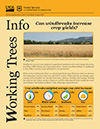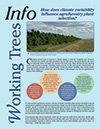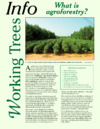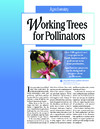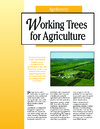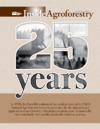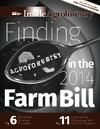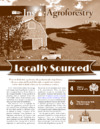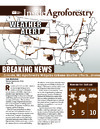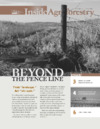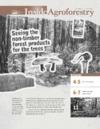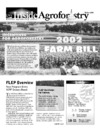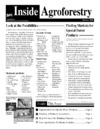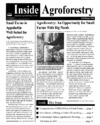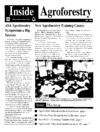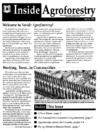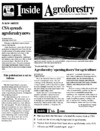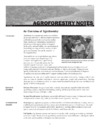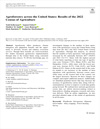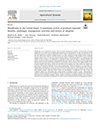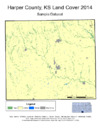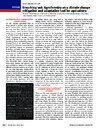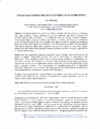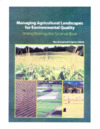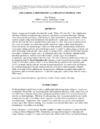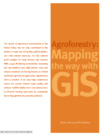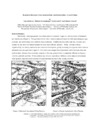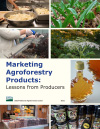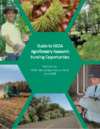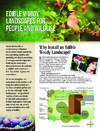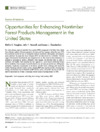Forest Farming
Forest farming is the cultivation of high-value crops under the protection of a managed tree canopy. In some parts of the world, this is called multi-story cropping and when used on a small scale in the tropics it is sometimes called home gardening. It is not just recreational harvesting or wild harvesting wild harvesting of native understory wood land plants without management; management is an essential part of forest farming. This approach to crop production intentionally uses both vertical space and the interactions of the plants and microclimate.
The intensity of forest farming production can vary depending on the producer’s goals, available markets, processing equipment and the site. Some examples of management activities include harvesting and scattering local seed; thinning out competing plants; additional site preparation for planting seeds, bulbs or plant starts; soil amendments for pH or fertility; constructed raised planting beds; pest control; and even fencing to keep out animals and poachers.

Often these woodland crops grown under a canopy are called Non-Timber Forest Products or NTFPs. Crops like ginseng, goldenseal, shiitake or other mushrooms, and decorative ferns are used or sold for medicinal, culinary, and ornamental uses. Forest farming can provide shorter-term income while high-quality trees are being grown for wood or other tree products.
Forest farming is most often used on private lands to supplement family income. Because of the demand and high value of some of these plants they can no longer be found in many places within their historic native range. Wild harvesting of these plants is not allowed on public land in many areas, making forest farming an important option for meeting demand for these plants. Even if the plants of interest are not present in a woodland, the careful inspection of the understory woodland plants may identify other non-economic plants that are often found with these more desirable NTFPs. If so, this may indicate a good location to reintroduce and grow the desired NTFP. Additional benefits of this intensified production is the regular attention in the woods may help to spot and control invasive plants and pests as well as the reduced harvest pressure on wild plant populations that allows them to be reestablished in other woodlands in the region.
Forest Farming Publications
Information Sheets
Infosheet

Infosheet

Infosheet

Infosheet

Infosheet

Infosheet

Infosheet

Infosheet

Infosheet

Infosheet

Infosheet

Infosheet

Brochures
Brochure

Brochure

Brochure

Brochure

Brochure

Brochure

Brochure

Inside Agroforestry
Inside Agroforestry

Inside Agroforestry

Inside Agroforestry

Inside Agroforestry

Inside Agroforestry

Inside Agroforestry

Inside Agroforestry

Inside Agroforestry

Inside Agroforestry

Inside Agroforestry

Inside Agroforestry

Inside Agroforestry

Inside Agroforestry

Inside Agroforestry

Inside Agroforestry

Inside Agroforestry

Inside Agroforestry

Inside Agroforestry

Inside Agroforestry

Inside Agroforestry

Inside Agroforestry

Inside Agroforestry

Inside Agroforestry

Inside Agroforestry

Inside Agroforestry

Inside Agroforestry

Inside Agroforestry

Inside Agroforestry

Inside Agroforestry

Agroforestry Notes
Agroforestry Note

Agroforestry Note

Agroforestry Note

Agroforestry Note

Agroforestry Note

Agroforestry Note

Agroforestry Note

Agroforestry Note

Agroforestry Note

Agroforestry Note

Agroforestry Note

Research
Research

Research

Research

Research

Research

Research

Research

Research

Research

Research

Research

Research

Research

Research

Research

Research

Research

Research

Research

Research

Research

Research

Research

Research

Research

Research

Research

Research

Research

Research

Research

Research

Research

Research

Research

Research

Research

Research

More Publications
More Publications

More Publications

More Publications

More Publications

More Publications

More Publications

More Publications

More Publications

More Publications

More Publications

More Publications

More Publications

More Publications


